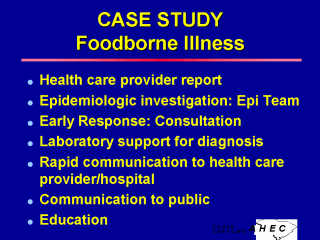| front |1 |2 |3 |4 |5 |6 |7 |8 |9 |10 |11 |12 |13 |14 |15 |16 |17 |18 |19 |20 |21 |22 |23 |24 |25 |26 |27 |28 |29 |30 |31 |32 |33 |34 |35 |review |
 |
Learning Activity: Application of Public Health Approach to a Case Study of a Foodborne Illness at a State Supported University. Case study: At a state supported university, students were reporting to the school infirmary with gastrointestinal complaints. Concerned about the number of students with the same symptoms, the infirmary nurse contacted the local health department. The depth of the investigation of foodborne illness varies depending on the circumstances and the causative agent. If a preliminary investigation reveals a cluster of cases with similar illness/symptoms, a thorough investigation is warranted to identify and control the source. The health department sent in an Epidemiology Team to do a thorough investigation - collect stool samples, take food histories from persons who were ill and those who were not ill, and collect food samples. The Epi team also established that the outbreak was confined to campus by surveying a sample of local providers and emergency rooms for increases in reported cases of diarrhea. They found none. More than 200 students were affected. Through interviews, it was determined that all who were sick had eaten at the salad bar in the cafeteria. The laboratory confirmed a diagnosis of Salmonella. Through examining food histories and food samples, the source of contaminated food was determined to be boiled eggs Steps were put in place to prevent the spread or reoccurrence of this situation, and cafeteria workers were provided education and training in safe food preparation and handling. |
| front |1 |2 |3 |4 |5 |6 |7 |8 |9 |10 |11 |12 |13 |14 |15 |16 |17 |18 |19 |20 |21 |22 |23 |24 |25 |26 |27 |28 |29 |30 |31 |32 |33 |34 |35 |review |